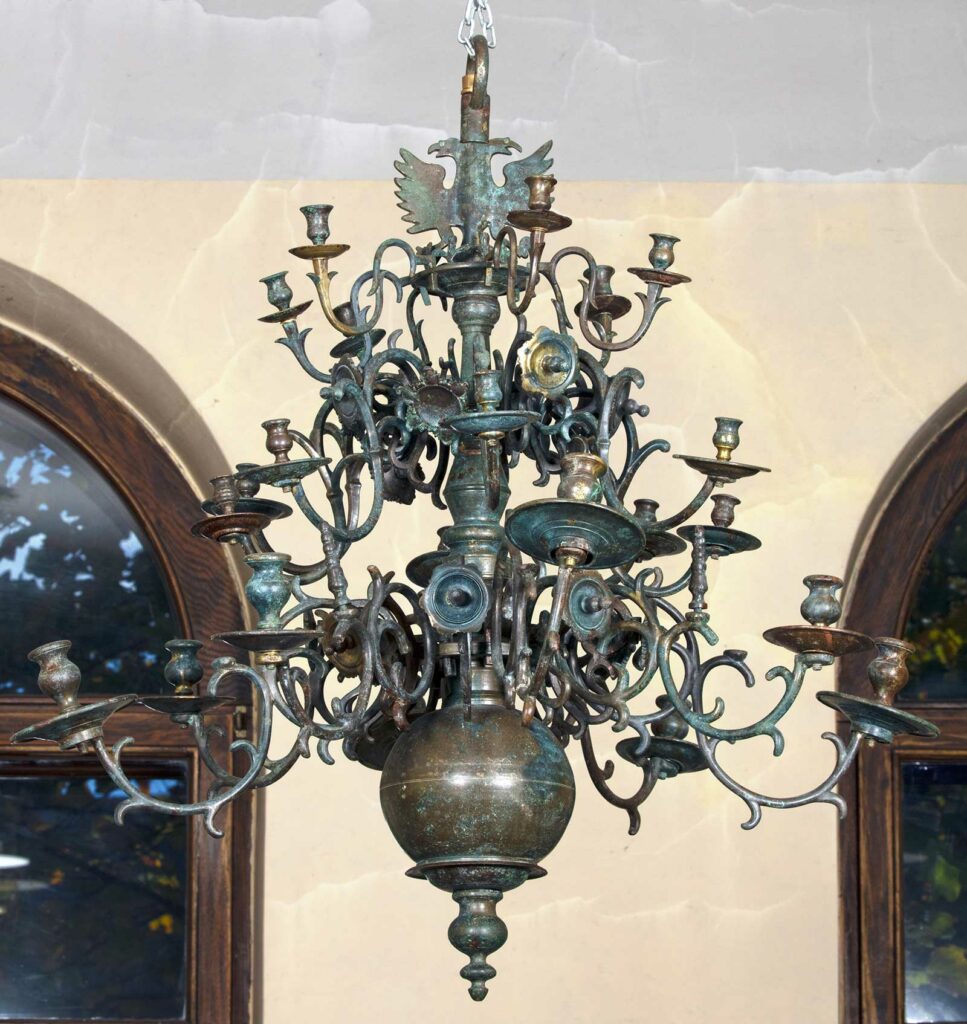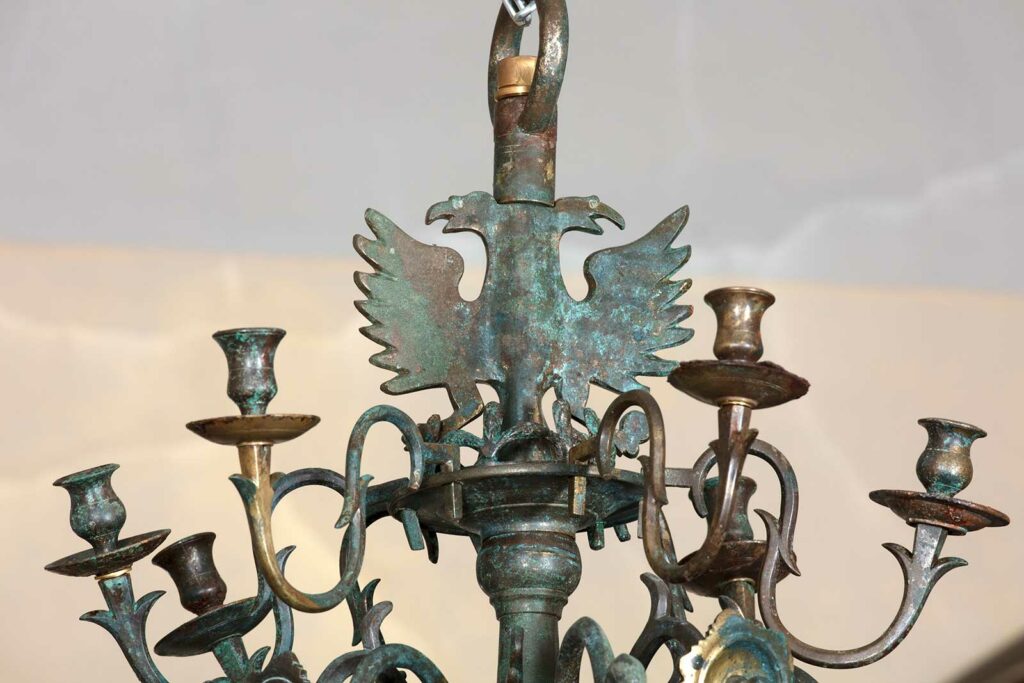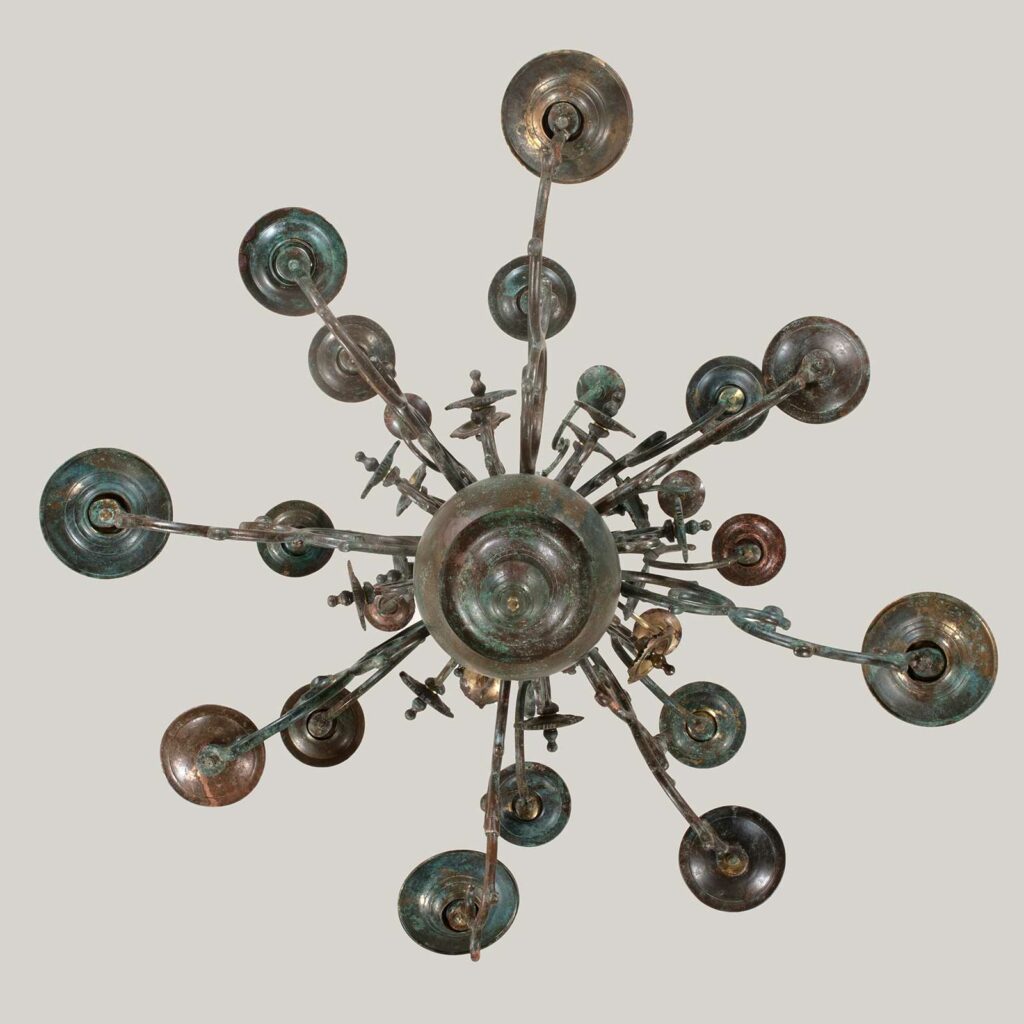The chandelier, one of many in the Great Synagogue of Oświęcim, was found on Berka Joselewicza Street in Oświęcim, at the site of the temple that was destroyed by the Germans in November 1939. In 2004, archaeologists from the Nicolaus Copernicus University in Toruń, under the direction of Dr. Małgorzata Grupa, carried out work at the site, during which they discovered more than 400 items of furniture from the temple, including a Ner Tamid (Hebrew for eternal light) lamp and many candlesticks and chandeliers. The work was initiated by Yahali Gata and Yariv Nornberg of Israel. In 2019, in preparation for digitization, the chandelier was conserved as part of the ” Wirtualna Malopolska” project co-financed by the European Union from the European Regional Development Fund within the framework of the Regional Operational Program of the Malopolska Region for 2014-2020 and by the Malopolska Region. THE GREAT SYNAGOGUE IN OŚWIĘCIM -The most important synagogue in Oświęcim, also known as the Great Synagogue, was one of more than 20 Jewish places of prayer in the city during the interwar period. In 1588, a parcel of land was donated to the Jewish community by Jan Piotraszewski, a townsman and forester of Oświęcim. The first synagogue and Jewish cemetery were established there. Little information has survived about its further history. In all likelihood, the synagogue was originally a wooden structure, and later it was built of brick. Over the following centuries it was repeatedly destroyed, for example in fires that struck the town in 1711 and 1863. After the last of these, as a brick building, it fulfilled its function again as early as in 1873. Jewish residents of Oświęcim recalled that the building could accommodate nearly 2000 worshippers, and its monumental silhouette stood out in the skyline of Oświęcim, emphasizing the established position of the local Jewish community. The appearance of the Great Synagogue, known from surviving photographs from the early twentieth century, was shaped in the years 1890-1900 based on a design by the famous Bielsko architect, Karol Korn. The synagogue received a representative, richly decorated facade with elements of Neo-Romanesque, Neo-Gothic, Moorish and arcade styles (German: Rundbogenstil). Its character resembled that of other synagogues designed by Korn (Biała and Wadowice), and the details of its decoration alluded to the decorations of the Reform Tempel Synagogue on Miodowa Street in Cracow. Inspiration for its architectural form should also be sought in German architecture, particularly in the Hamburg synagogue of Albrecht Rosengarden. The facade, referring to German models, was a clear sign of the modernization tendencies that dominated the Oświęcim community in the second half of the nineteenth century. The Great Synagogue was attended, to a large extent, by progressive Jewish intellectuals (including doctors, lawyers, businessmen, and clerks), and to a small extent by traditionalists. The chief rabbis of the Jewish community in Oświęcim, who successively conducted services in the synagogue between 1873 and 1939, included: Lazar Münz, Shlomo Halberstam, Abraham Schnur, Osias Pinkas Bombach, and as the last, his son, Elijah. Berka Joselewicza Street, also known as Żydowska Street, where this and many other synagogues were located, was the center of Jewish religious and social life in Oświęcim from the second half of the 16th century. The Great Synagogue was burned and destroyed by the Germans during World War II, on the night of November 29-30, 1939. The last traces of the Great Synagogue were removed on German orders by a specially created commando made up of Auschwitz prisoners, mostly Poles, who completed the demolition of the building as forced labor in the summer of 1941. “Its interior was beautiful. There were wonderful frescoes on the walls, topped with a dome like a chupa [Hebrew for wedding canopy]. On the ceiling was painted a blue sky dotted with stars and decorated with the twelve signs of the zodiac. The bimah [Hebrew, Torah reading stand] was located on an elevated platform and was enclosed by a structure of wrought iron, brass, and carved wood. The interior of the temple was softly lit by candles, since electricity did not initially reach Oświęcim. However, it was the Great Synagogue that was the first building in the city where electric lamps were installed. They were turned on for the first time during services that began in the year 5686 [1925]. It only took one night in the winter of 5700 [November 1939] for all the splendor of the Great Synagogue to collapse. Special groups of uniformed Germans patrolled the streets – may the memory of them be erased. They made an impression of being experienced in destroying synagogues. They quietly approached the building and set it on fire. The fire that broke out was unstoppable. It was a living hell. The Germans surrounded the entire area and threatened to shoot anyone who dared to leave their home. Officially, a “strict curfew” was imposed. Jews were allowed at most to weep as they watched from a distance as the fire consumed the House of the Lord. [translated by Maciek Zabierowski].
| Inventory number: | MZ-8-O |
| Name: | Chandelier from the Great Synagogue in Oświęcim |
| Source: | Great Synagogue in Oświęcim |
| Dating: | turn of 19th and 20th centuries |
| Dimensions: | basic: height 110 cm |
| Material: | no information |
| Execution technique: | no information |
Digitalisation: Regional Digitalisation Lab, MIK, Oshpitzin means Oświęcim project.




